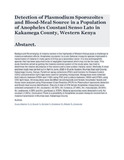Detection of Plasmodium Sporozoites and Blood-Meal Source in a Population of Anopheles Coustani Senso Lato in Kakamega County, Western Kenya
Date
2022-01-31Author
Ayuya, Stephen
Busula, A. O.
K, Nicholas
K., Mukabane
M., Webale
Omukunda, E
Metadata
Show full item recordAbstract
Background Re-emerging of malaria vectors in the highlands of Western Kenya pose a challenge to malaria eradication efforts. Anopheles coustanis.l is a sub-Saharan mosquito species implicated in transmission of malaria in many parts of Africa as a secondary vector. It is zoo-anthropophilic species that has been assumed to be of negligible importance which may not be the case. This study therefore aimed at getting the malaria vectorial system of the study area, has tried to determine the relative abundance of the vectors and a new outdoor malaria vector. Methods A cross sectional study was carried out in April to June, 2020 in Eluche location, Mumias East sub-County, Kakamega County, Kenya. Pyrethrum spray collections (PSC) and Centers for Disease Control (CDC) and prevention light traps were used for sampling mosquitoes. Mosquitoes were collected both indoors; between 0700h and 1100h using PSC and outdoors between 1800h and 0700h using CDC light traps. All mosquitoes were identified morphologically and female Anopheles’ heads and thorax were analyzed using Polymerase Chain Reaction (PCR) for Plasmodium sporozoite detection and blood-meal source identification. Results A total of 376 female Anopheles mosquitoes were collected composed of: An. coustanis.l, 42.55%; An. funestus, 27.66%; An. maculipulpis, 25.00%; An. arabiensis, 4.26% and An. gambiaes.s, 0.53%. Malaria sporozoites were detected in only An. coustani (1.06%). Conclusion There is a possibility of Anopheles coustani mosquito involvement in malaria transmission in Mumias east, Kakamega County.
URI
https://doi.org/10.24940/ijird/2022/v11/i1/JAN22031http://ir-library.mmust.ac.ke:8080/xmlui/handle/123456789/2133
Collections
- Journal Articles [411]

